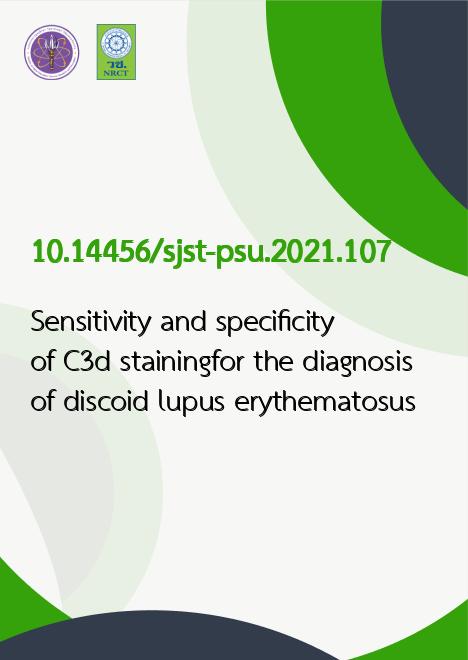
|
Sensitivity and specificity of C3d stainingfor the diagnosis of discoid lupus erythematosus |
|---|---|
| รหัสดีโอไอ | |
| Creator | 1. Apasee Sooksamran 2. Jade Wititsuwannakul 3. Penvadee Pattanaprichakul 4. Nutpacha Chotikawichean |
| Title | Sensitivity and specificity of C3d stainingfor the diagnosis of discoid lupus erythematosus |
| Publisher | Research and Development Office,Prince of Songkla University |
| Publication Year | 2564 |
| Journal Title | Songklanakarin Journal of Science and Technology (SJST) |
| Journal Vol. | 43 |
| Journal No. | 3 |
| Page no. | 810-815 |
| Keyword | C3d, discoid lupus erythematosus, formalin-fixed paraffin-embedded specimens, specificity, sensitivity |
| URL Website | https://rdo.psu.ac.th/sjstweb/ |
| ISSN | 0125-3395 |
| Abstract | Discoid lupus erythematosus (DLE) can be clinically and histologically challenging to diagnose. Some laboratoriesprovide immunofluorescence testing, but this requires fresh tissue. C3d staining for the diagnosis of DLE in formalin-fixedparaffin-embedded specimens was used to determine the sensitivity and specificity of detection of this complement protein. Wetested 59 cases of DLE and a control set composed of 59 cases of lichen planus (LP), 9 cases of LP-like keratosis, 5 cases ofcheilitis, and 3 cases of mucositis. Blinded assessment of the C3d staining was carried out by three pathologists. Fisherโs exacttest, the independent t-test, and kappa analysis were used for analyzing the sensitivity and specificity of C3d, which were 44%and 97%, respectively. C3d staining in dermoepithelial junctions confirmed DLE and excluded LP. C3d staining in DEJ isspecific for DLE but has low sensitivity. |
